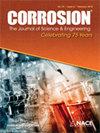材料需求和消费增长对腐蚀科学、工程和技术界的挑战:可持续性问题
IF 1.3
4区 材料科学
Q4 MATERIALS SCIENCE, MULTIDISCIPLINARY
引用次数: 0
摘要
这一观点旨在使腐蚀界认识到,我们日益发展的技术社会对工程金属材料的需求不断增长是不可持续的。目前的战略重要的材料科学,特别是腐蚀界提出。首先,回顾了金属的消费,并在不同的情况下讨论了金属的全球供应和需求,包括全球社会发展模式。有人指出,预期的未来消费率对世界各地经常使用的特定元素的供应造成压力,元素周期表上的几乎每一种元素现在都用于生产新的技术装置。这种消费将金属的开采和生产推向了应该用包含金属可持续性战略的新颖工程和技术方法来平衡的水平。“制造-使用-丢弃”等标准方法必须逐步转变为采用“减少-再利用-再循环”方法的循环经济范式。虽然回收可以增加工程材料的供应,但不断增长的需求需要采取额外的行动来显著保护自然资源并延长金属的可持续性。介绍了腐蚀社区对循环可持续经济概念的贡献能力。维护策略和腐蚀管理控制可能还不够,需要与现有或新兴的新技术相辅相成,如增材制造、逆向工程设计和溶剂冶金,并结合集成设计、建模和机器学习方法。从开采到设计、生产、使用、再利用和回收,腐蚀社区可以在不同层面影响组件和基础设施的寿命终结。讨论了每个过程步骤,寻求可能的解决方案来保护金属资源,例如,实现更高效和高产的采矿,设计和建模新材料,提高生产效率,引入轻量化和智能材料,以及开发更有效的回收,再循环和分离。本文章由计算机程序翻译,如有差异,请以英文原文为准。
Challenges for the Corrosion Science, Engineering, and Technology Community as a Consequence of Growing Demand and Consumption of Materials: A Sustainability Issue
This perspective is intended to bring awareness to the corrosion community that the growing demand for engineering metallic materials required for our increasingly technological society is unsustainable. Current strategies important for materials science and especially the corrosion community are presented. First, the consumption of metals is reviewed, and the global supplies and demands of metals are discussed given different scenarios, including models of global societal development. It is pointed out that expected future consumption rates place pressure on the availability of specific elements used regularly throughout the world, with nearly every element in the periodic table now utilized in production of new technological devices. The consumption pushes the mining and production of metals to levels that should be counterbalanced with novel engineering and technological methods that incorporate strategies for metal sustainability. Standard approaches such as “make-use-dispose” must gradually be transformed into a circular economy paradigm embracing the “reduce-reuse-recycle” approach. Although recycling can bolster the engineered material supply, the growing demands require additional actions to significantly preserve natural resources and prolong metal sustainability. Our views on the abilities of the corrosion community to contribute to the concept of a circular sustainable economy are introduced. Maintenance strategies and corrosion management control may not be sufficient and need to be complemented with existing or emerging new technologies such as additive manufacturing, inverse engineering design, and solvometallurgy in combination with integrative design, modeling, and machine learning approaches. The corrosion community can impact the end-of-life of components and infrastructure at different levels, starting from mining through design, production, use, reuse, and recycling. Each process step is discussed, seeking possible solutions to preserve the metal resources by, for example, achieving more efficient and high-yield mining, designing and modeling new materials, increasing production efficiency, introducing light-weighting and smart materials, as well as developing more efficient recovery, recycling, and separation.
求助全文
通过发布文献求助,成功后即可免费获取论文全文。
去求助
来源期刊

Corrosion
MATERIALS SCIENCE, MULTIDISCIPLINARY-METALLURGY & METALLURGICAL ENGINEERING
CiteScore
2.80
自引率
12.50%
发文量
97
审稿时长
3 months
期刊介绍:
CORROSION is the premier research journal featuring peer-reviewed technical articles from the world’s top researchers and provides a permanent record of progress in the science and technology of corrosion prevention and control. The scope of the journal includes the latest developments in areas of corrosion metallurgy, mechanisms, predictors, cracking (sulfide stress, stress corrosion, hydrogen-induced), passivation, and CO2 corrosion.
70+ years and over 7,100 peer-reviewed articles with advances in corrosion science and engineering have been published in CORROSION. The journal publishes seven article types – original articles, invited critical reviews, technical notes, corrosion communications fast-tracked for rapid publication, special research topic issues, research letters of yearly annual conference student poster sessions, and scientific investigations of field corrosion processes. CORROSION, the Journal of Science and Engineering, serves as an important communication platform for academics, researchers, technical libraries, and universities.
Articles considered for CORROSION should have significant permanent value and should accomplish at least one of the following objectives:
• Contribute awareness of corrosion phenomena,
• Advance understanding of fundamental process, and/or
• Further the knowledge of techniques and practices used to reduce corrosion.
 求助内容:
求助内容: 应助结果提醒方式:
应助结果提醒方式:


